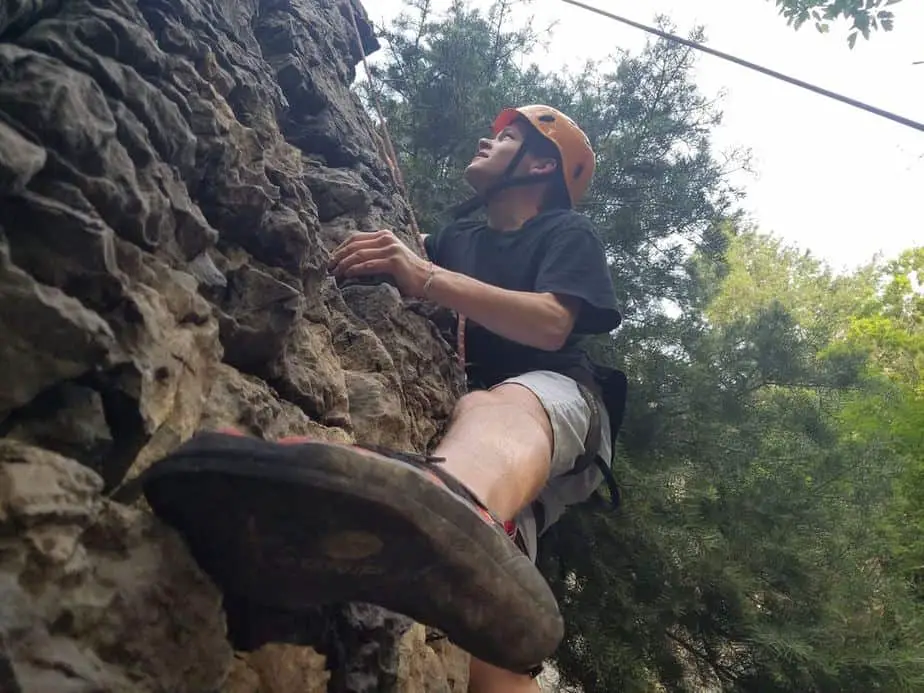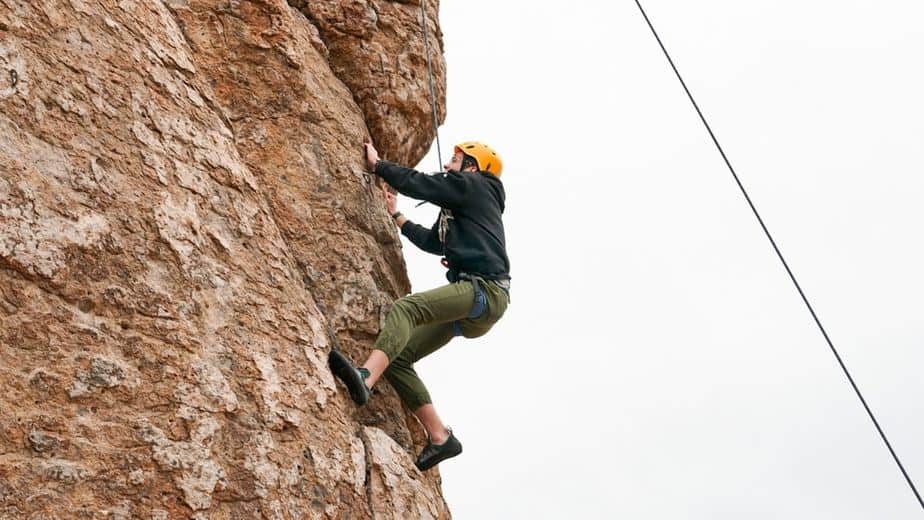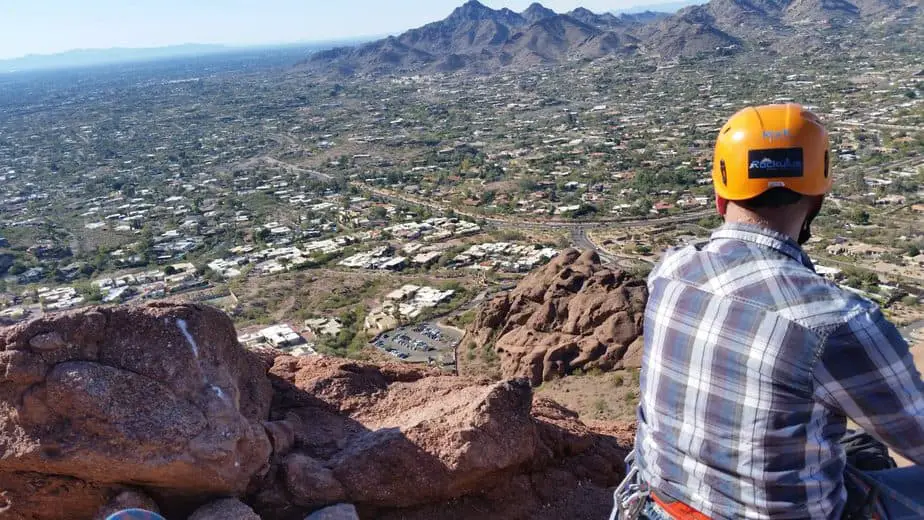If you dress poorly for indoor climbing, it’s really not a big issue. As long as your clothing is somewhat flexible and durable, you’re going to be fine. The climate-controlled atmosphere inside climbing gyms is conducive to all climbing styles. What about climbing outdoors though?
In hot weather, wear a thin long-sleeved shirt over the top of a t-shirt or tank top, and thin long pants or shorts (or convertible zip-offs). For cold weather, add another layer underneath, and another few on top as needed. Climbing outdoors is more dangerous than climbing indoors, largely due to the remoteness of the crags and exposure to the elements.
In the backcountry, the weather can change in an instant. Clouds hidden behind the very mountain you’re climbing can emerge suddenly and pour rain or snow on top of you. Here are my recommendations for what to wear and bring when rock climbing outdoors so that you are always prepared.
Clothing for Outdoor Climbing

Rock Climbing in Warm Weather
Living in Arizona, I end up climbing on days when the weather is well above 90 degrees F. Climbers from other parts of the country and world wouldn’t dream of even going outside when it’s 100+ outside, but we are a strange breed. Whenever possible, I try to make it a point to go deep water soloing instead, but the options near me are few and far-between.
Head: Your main enemy when climbing in warm weather is the sun. Aside from obvious ailments like sunburns, you become more likely to get heat exhaustion, heatstroke, or hypothermia by spending a lot of time in direct sunlight.
A good helmet (because everyone should always wear a helmet climbing or belaying outdoors!) with vents will allow air to pass through while still providing some sun protection for your face and scalp.
Wear a hat for sun protection when you aren’t climbing. Probably a hat with your favorite climbing brand’s logo on it.
See our recommended helmets in our gear guide .
.
Torso: As mentioned above, the key here is versatility. I usually bring a thin long-sleeved button-up shirt to protect my arms from the sun while I’m belaying. I wear this shirt over the top of a thin t-shirt. If I’m out of direct sunlight or when I’m actually climbing, I take the sun shirt off and just wear the t-shirt.
Make sure the sun shirt is big and loose enough that you can have a full range of motion. Additionally, I recommend keeping a light rain jacket in your backpack in the event of an unforeseen microburst.
Amazon: Columbia Sportswear Women’s Bahama Long Sleeve Top
Amazon: Columbia Men’s Bahama II Long Sleeve Shirt
Hands: You won’t want to wear any gloves on your hands while climbing in the heat, though you can use some fingerless ones to belay if you really want to. Chalk goes a long way when climbing in the heat, so make sure to fill up your chalkbag before you start! It can be a life-saver.
For crack climbing, most people either tough it out or tape up their hands really good using athletic tape to take the edge off.
Legs: I generally prefer to climb in shorts during hot days, unless I’m doing some crack climbing. For crack climbing, it’s better to scrape your pants up than your knees. It can be frustrating to wear long pants during the cool mornings and then to want to switch to shorts as the day warms up. The most obvious solution to this is to wear convertible pants aka zip-offs. Apparently, this makes you look like a dork (according to my wife), but we can sacrifice beauty for utility, right?
I wrote up a review of the best climbing pants we use and recommend, which you can read here- Are Climbing Pants Worth It?
If you do choose to wear shorts, I recommend shorts that are long enough so that your harness straps don’t dig into bare skin. Leggings are probably the most popular climbing pants for women- Katherine wrote a post about that you can read here- Rock climbing in leggings .
.
Feet: There are specific shoes designed for the strenuous and demanding approach to many climbing areas, aptly named Approach Shoes. They are designed to be bullet proof with very grippy rubber. In general, I recommend avoiding shoes that are waterproof since they don’t breathe very well.
I really have liked the Adidas Terrex family of shoes, since they fit comfortably like a tennis shoe but contain the components of their subsidiary- Five Ten. Most of them even use the Five Ten Stealth Rubber for maximum traction. Alternately, you can just wear a pair of tennis shoes or hiking boots.
Amazon: Approach Shoes
A thin pair of merino wool socks will keep your feet dry by wicking the sweat away. Merino wool is extremely breathable, and doesn’t hold moisture to your skin like other products. These socks won’t turn your feet into saunas either, like regular wool. They are quick drying, and don’t have the same scratchy texture that regular socks have.
Amazon: Fox River All-Weather Socks
As far as your rock climbing shoes go, there’s really no good way to keep them dry and cool. Keep them out of the sun when you aren’t climbing, and take them off between routes to let them air out.
I usually wear a pair of sandals while I’m belaying. If your feet get really sweaty, you can try adding a bit of loose chalk inside of them before climbing, or even wearing a thin pair of socks with them.
Your climbing shoes will undoubtedly get pretty nasty over time, especially when climbing in hot weather. Read my post How to Clean Rock Climbing Shoes- 5 Simple Steps for instructions on keeping them clean, and how to best clean them.
for instructions on keeping them clean, and how to best clean them.

Rock Climbing in Cool Weather
There’s nothing better than a nice cool day for climbing. No shivering or sweating while you’re belaying, no sweaty handholds or frozen digits while you’re climbing.
Head: The recommendations for cool weather climbing are pretty much the same as those for warm weather. Wear a helmet!
Torso: As the temperature changes throughout the day, you may find it convenient to start with a long-sleeved shirt over the top, remove it, and then eventually add a light jacket in the evening. It really doesn’t matter much what you wear, as long as it isn’t cotton.
Depending on where you are, rain could be a problem. In most areas, it’s not recommended to climb in the rain, since rain weakens and damages sedimentary rock. For really hard rocks though, it’s not as much of an issue.
As long as your rope is dry rated, and you’re patient with slippery conditions, you’re good to go. If you’re in an area where it is okay to climb wet rock, bring along a rain jacket and way to keep your belongings dry like a small dry bag.
Amazon: The North Face Men’s Millerton Jacket
Take a look at the dry bags and packs we use in our Recommended Gear Guide .
.
Hands: You shouldn’t need gloves for cooler weather, unless you want to use leather gloves to belay.
Legs: Climbing is best with long pants. Pants help protect your knees and legs from bumps, scrapes, and bruises. Read our review of the best climbing pants in this post.
in this post.
Feet: Approach shoes are definitely the best-suited footwear for hiking in to climbing areas since that’s what they’re designed for, but tennis shoes and hiking boots do fine as well. The advantage to approach shoes is the enhanced durability and grip. Many of them even have a toe cap made of climbing-grade rubber to help you scramble up class-4 and class-5 approaches.
I’ve really been impressed with the Adidas Terrex family of shoes for the outdoors, borrowing some of the technology from their subsidiary 5.10. Again, Merino Wool is king for socks.
See links above.
Rock Climbing in Cold Weather
Just like I have to climb in temperatures above 90 F because of where I live, people in colder climates have to put up with the weather they’re dealt. I’m going to go out on a limb and say that if you are ice climbing or mountaineering, you already have a plan for what to wear (and it probably cost you an arm and a leg).
Climbing in really cold weather is just plain miserable, but some climbers do it anyway. Fortunately, it’s not as hard to stay warm if you can stay dry.
Head: Wear a beanie underneath your helmet. Doing this alone will warm your body up significantly since a lot of heat escapes through your head. In really cold temperatures, a balaclava will help to keep your neck and face warm as well. Or just grow a big beard, right?
Torso: The key to keeping warm while climbing in cold weather is to layer up. Start with a pair of thermals on the bottom. I’ve found that one pair is enough to keep me warm without overheating when the temperature is above about 20 degrees Fahrenheit, with additional outer layers. The difficulty is in switching between the belay and climbing, since you cool off rapidly while belaying.
With a thermal under layer, a short and long-sleeved shirt on top of that, a light fleece layer or puffy and a waterproof outer coat, you should stay pretty toasty while belaying. A lot of the time I just hand off the two jackets to the belayer while I climb, and then trade off while he or she climbs.
Amazon: Columbia Women’s Ridge Repeat Half Zip Fleece
Amazon: Columbia Men’s Granite Mountain Fleece Jacket
Hands: The worst thing about climbing in the cold is keeping your hands from freezing. While your feet are at least somewhat protected from the wind, your hands are stuck up above your head causing the warm blood to drain out of them as they grip the ice-cold rock.
Your best bet here is to go with some fingerless gloves for climbing, and bring along some hand warmers to use during your breaks. Keep the hand warmers in your pockets with your hands whenever you aren’t climbing.
When you’re belaying, wear a pair of liners or thin gloves inside of a pair of heartier leather gloves. The liners will warm your hands up, and the leather gloves will protect them from wear and tear.
Glove Liners on Amazon: Outdoor Research PL Base Sensor Gloves
Leather Climbing Gloves on Amazon: Petzl – CORDEX, Lightweight Climbing Gloves
A couple of years ago, Black Diamond launched a product (on April Fools’ Day) to combat this problem- the heated chalk bag. We laugh about it now, but I’m sure it would be nice in some situations!
Black Diamond heated chalk bag
Legs: Legs are often harder to keep warm than your upper body, since you can’t just add an extra jacket. The most important thing to start with is a good base layer. In really cold weather, a second one is nice. On top of that, I recommend a pair of insulated hiking pants. They’re basically waterproof pants lined with fleece. You’ll stay warm as you keep moving around. Jumping jacks are your friend.
Feet: In snowy conditions, waterproof insulated boots will be your best friend. Throw a pair of foot-warmers in the bottom as well for added joy/reduced pain. Wool socks will keep your feet warm- consider two pairs during really cold temperatures, but don’t let them interfere with your blood circulation. If you have money to spare, or want to pick up another awesome activity, mountaineering boots are the way to go.
The rubber of your climbing shoes does a pretty good job keeping the insides dry, but your feet will still get fairly cold. You’ll notice that it’s more difficult to ‘feel’ out where the small holds are, and more difficult to trust that they’ll hold you.
That’s because the rubber is less grippy in cold temperatures as it hardens up. You can add a pair of thin wool socks to your climbing shoes to try and take the edge off, but your feet will be cold (and people might laugh at you).

Tips for Managing Temperature Changes While Climbing
- Not every day ends up being 70 degrees Fahrenheit, though I think that is the perfect temperature for rock climbing.
- A long or vertical hike in will likely make you sweat. It might be cold when you first get out of the car, but I usually shed a layer and start out cold as I hike in. I warm up pretty quickly while hiking, and this way I don’t get sweaty before we start.
- Depending on how early you start, you will likely experience a swing of 20-30 degrees during the first few hours of the day as the sun comes up and begins to warm the canyon walls. Keep that in mind as you’re planning what to wear.
- As you trade belays, you will want to be able to quickly add or remove a light jacket so you stay warm in between routes. The belayer can keep the jacket warm for the climber by wearing it.
- Storms can come out of nowhere while in the backcountry, especially in mountainous regions where only a small portion of the sky is visible. Be prepared to bail in the event of bad weather. You don’t want to be up high on a wet wall when lightning strikes.
- Stay fueled and hydrated. Your body can’t regulate your temperature as well when you’re dehydrated or really hungry.
Related Questions:
What to wear for indoor climbing? Katherine wrote a great post about this that you can read here: Indoor Climbing Attire
Is Rock Climbing Safe? Climbing is almost completely safe. We took a look at lots of different accidents that happen indoors, as well as those that happen indoors. The overall analysis is that accidents can happen when people make mistakes- but things like gear failure rarely (never) happen. Read more in this post- Is Indoor Rock Climbing Dangerous?

